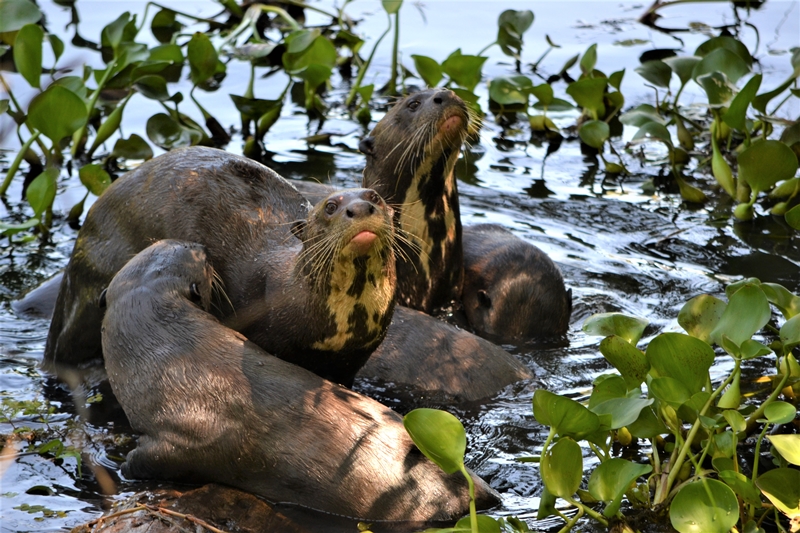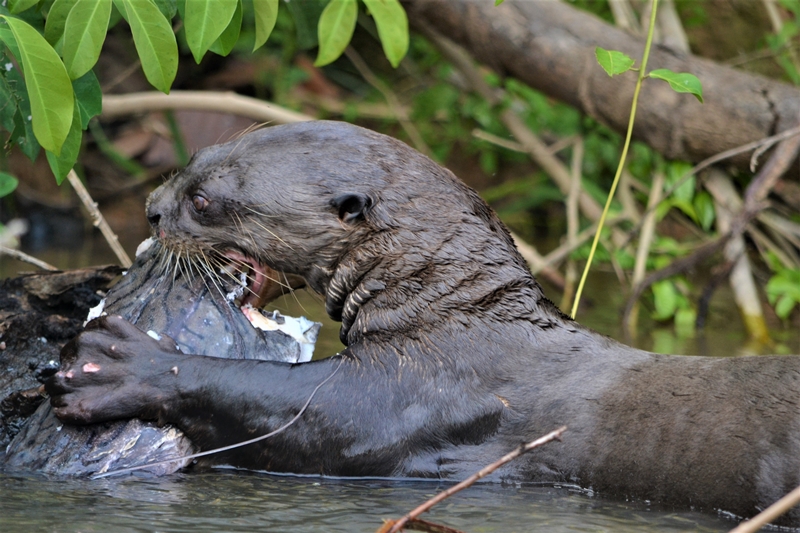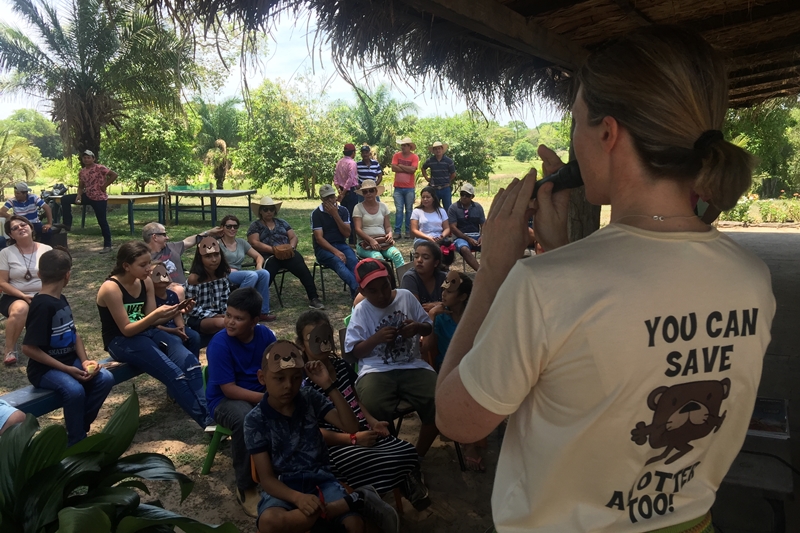
Project: To support fieldwork to identify potential migration corridors and core recolonization areas for Giant Otters in Brazil.
2024 Project Partner: Projeto Ariranhas
Find out more about Projeto Ariranhas here>>.
Donate or Set up a Fundraising Page to support this project here.
Projeto Ariranhas
Projeto Ariranhas (The Giant Otter Project) was set up in 2019 to help conserve the world’s largest otter and its ecosystem in Brazil.
The small team of twelve is 93% Brazilian and 78% female, reaffirming the institution’s commitment to bolster the role of Brazilian women in research and conservation.
The project is overseen by the Giant Otter Conservation Fund (GOCF) with a mission to promote the giant otter as a symbol of ecosystem balance and advocate for harmonious human-wildlife coexistence.
Through the integration of scientific research, environmental education, science communication, and the development of sustainable tourism, the Giant Otter Project achieves significant outcomes.
Projeto Ariranhas collaborates with different partners, including the UK-based International Otter Survival Fund which supports conservation of all thirteen species of otter worldwide.
Giant Otters
Endemic to South America, the Giant Otter Pteronura brasiliensis is listed as Endangered by the IUCN Red List of Threatened Species. The giant otter plays a vital role in maintaining fish stocks and ecosystem balance in South American river systems. Keystone species such as this are important indicators of overall environmental health.
Given their size and charisma, giant otters serve as flagship species for conservation, and the chance to see them on Brazil’s waterways is beneficial to the growth of wildlife ecotourism.
Giant otters are very social, using a range of vocalisations to communicate. They live in family groups of around 8- 20 individuals, making dens (holts), campsites, and latrines in the riverbank or along the shore, and using the available vegetation. There is usually a dominant breeding pair, non-breeding sub-adult pair and offspring. They are very territorial.
Their strong streamlined bodies can be as long as 1.8 metres. A muscular tail, short legs and large webbed feet make them agile and well-adapted for hunting fish in water.
They take a long time to reach sexual maturity, having 1 to 3 cubs, and cub survival rates are low. This makes any population recovery a slow process.
It is unclear what the global population of giant otters looks like, but there are estimated to be fewer than 5,000 giant otters remaining in Brazil . These populations are fragmented and confined to pristine areas in the Pantanal, Amazon, and a small portion of the Cerrado Biome.
Main Threats
Historically, the giant otter population suffered significant decline due to the pelt trade.
Their preference for pristine waterways puts them at increasing risk from human pressures, including agricultural expansion, mining, and cattle ranching. The degradation of these habitats has been exacerbated by climate change – in particular, wildfires.
Human conflicts and poorly managed tourism also pose a threat to giant otters.
Project Area & Work
There has been monitoring of giant otters in the Pantanal for over a decade. Since 2019, The Giant Otter Project has established three important control areas, two in the Pantanal (Rio Negro and Porto Jofre locality) and one in the Cerrado (Rio Tocantins).
Alongside population monitoring in these areas, the team also conducts educational outreach with the local community. It is vital to understand human perception toward the giant otters, and to raise awareness about their value in the ecosystem. A ‘Team Otter’ club for children is an important part of this work.
The Project also provides training for tourism professionals with 342 guides trained to date in the three study areas, and informative lectures offered for tourists. Training ensures that tourism activities are more educational and less impactful on the species. The ability to provide high quality wildlife ecotourism experiences is vital to the conservation of the giant otter and its ecosystem. Responsible ecotourism adds a tangible value, offering jobs and income streams for the community. Every year, the demand for training increases, which is very encouraging, and there has been a rise in the number of tourism professionals and tourists taking part in otter monitoring activities with these collaborations helping to identify and catalogue 412 different giant otters.
Range
Looking at the giant otter’s current range, the Pantanal hosts the southernmost population (with the giant otter regarded as locally extinct any further south). Studies indicate that the Pantanal population has the lowest genetic variability, which makes it very vulnerable to negative impacts. In recent years, the Pantanal has suffered a prolonged drought, and subsequent wildfires have destroyed hundreds of thousands of hectares of the landscape, with a prolonged impact on the giant otter’s reproduction rate as documented by Caroline Leuchtenberger, founder of The Giant Otter Project.
Although conservation actions will continue in all the study sites (in Pantanal, Amazon, and Cerrado) ensuring protection and the long-term viability of giant otter populations, it is the Pantanal population, considered the most fragile of the three, that Sketch for Survival funding will be directed to.
Identifying Migration Corridors
The goal is to identify potential migration corridors and suitable recolonization areas for giant otters. This will be achieved through field-based surveys and the establishment of a monitoring programme in collaboration with local communities. Recolonization of giant otters in their historical ranges aligns with both the Brazilian Conservation Action Plan for the Species and the Global Otter Conservation Initiative by the IUCN.
Once suitable areas have been identified by the surveys, it will be possible to develop a long-term conservation strategy, and to make recommendations to expand, improve or create new protected areas based on the research. It will also be possible to review the current management plan of existing protected areas to ensure their effectiveness in the protection and conservation of giant otters.
Images courtesy of Caroline Leuchtenberger, projetoariranhas.org








